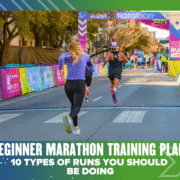Beginner Marathon Training Plan: 10 Types of Runs You Should Be Doing
Starting your first half or full marathon training plan? Whether you’re gearing up for the Austin Marathon or another 13.1 or 26.2 adventure, the key to crossing that finish line is variety. Each run in your training toolkit serves a unique purpose—building endurance, sharpening speed, and keeping injuries at bay.
Let’s break down the 10 essential types of runs every beginner should know:
1. Long Runs – Build Your Distance Engine
Long runs are the heart of your weekly training. They build the endurance needed to cover the race distance. Keep the pace steady and conversational. It’s about time on your feet, not racing your watch.
2. Tempo Runs – Push Your Comfort Zone
Tempo runs help your body learn how to sustain effort over longer periods. Run at a “comfortably hard” pace—not sprinting, but definitely working. They train your mental grit and physical stamina for race day.
3. Interval Runs – Speed in Spurts
Intervals combine short bursts of faster running (1–5 minutes) with recovery periods. This boosts your cardiovascular fitness, running economy, and race pace tolerance. Think of them as your speed secret weapon.
4. Pick-Ups – Sprinkle in Speed
Add 15–60 second bursts of quicker running during your easy runs. Pick-ups help improve turnover and efficiency without the intensity of full-on intervals.
5. Easy Runs – Your Recovery Lifeline
These runs are gentle, relaxed, and critical for recovery. Keep the pace slow, breathe easy, and let your body bounce back. Spoiler: these miles matter just as much as your speed work.
6. Base Runs – Mileage That Matters
Base runs are your consistent, moderate-length runs. They aren’t super slow or super fast—just steady. These build your aerobic base and set the foundation for everything else.
7. Soft Tempo Runs – The Middle Ground
A notch below a true tempo run, soft tempos hover near marathon pace. They’re great for days when you want a steady effort without the strain of a full-throttle workout.
8. Post-Run Strides – Form Focus
Strides are short accelerations (20–30 seconds) done after an easy run. They’re not sprints, but fast and smooth. Great for improving form, leg turnover, and prepping your body for harder efforts.
9. Hill Repeats – Strength Without the Gym
Find a moderate hill and run hard up, then recover down. Repeat! Hill repeats build strength, power, and mental grit—perfect for making race-day climbs feel easy.
10. Recovery Runs – Move to Mend
Done the day after a tough workout, recovery runs help loosen up sore legs while keeping your mileage consistent. They’re super short and super slow—and super important.
Bonus Tips for Training Success
- Warm up + cool down before and after every run.
- Listen to your body. Rest is part of the plan.
- Stay hydrated, fueled, and consistent.
- Join a local group or training program for extra motivation—like those from Fleet Feet or RAW Running.
Ready to Run Austin?
Now that you know the 10 essential types of runs, you’re ready to build a smarter, stronger training plan. Whether your goal is 13.1 or 26.2, this variety will get you across the finish line—faster, healthier, and with a smile.






